Although Dr. Anna Michel of Princeton University was in Beijing last summer during the Olympics, her visit definitely was not all fun and games. Michel, a postdoctoral researcher at MIRTHE (the Center for Mid-Infrared Technologies for Health and the Environment) arrived in Beijing in June 2008 as part of an international air quality monitoring project. Even before her plane touched down, it wasn’t hard to see that there was big trouble with the air in China.
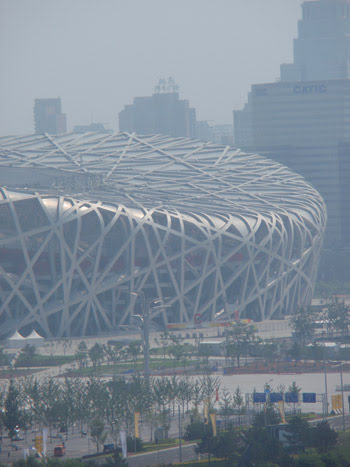
Beijing’s National Stadium, known as the Bird’s Nest, is seen on a hazy day. Courtesy Anna Michel, Princeton University.
“When I first got there, I was very shocked – I looked out the airplane window and could see the pollution. You could see the particulate matter in the air,” said Michel, whose three-month stay in Beijing began weeks before the Olympic Summer Games and ended after they concluded.
The sojourn that sent 10 members – undergraduates, graduate students and faculty – to China represented the first big international project for MIRTHE, a National Science Foundation (NSF) engineering research center founded in 2006 and based at Princeton. It is operated in partnership with City College of New York, Johns Hopkins University, Rice University, Texas A&M University and the University of Maryland. Researchers from Rice also participated in the Beijing project.
Serious business at MIRTHE
As an NSF engineering research center, MIRTHE is charged with taking new technologies – in this case a new platform for trace gas and chemical sensing – out of the lab and testing them under “real world” conditions to provide the push they need to become commercially viable products.
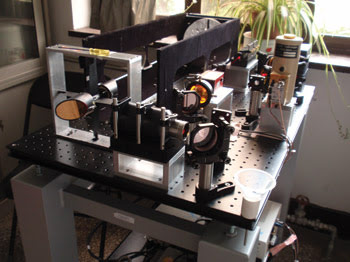
The Quantum Cascade Laser Open-Path System (QCLOPS) is used to measure trace gases. Courtesy Anna Michel, Princeton University.
MIRTHE develops mid-infrared laser sensors (3 to 27 μm) to detect gases such as ozone, ammonia, carbon dioxide and water vapor. The sensors also have applications in the medical field, such as detecting traces of ammonia on the breath for diagnosing kidney or liver disease.
The mid-IR range can sense almost any chemical that’s a vapor and whose composition is not highly symmetric, said MIRTHE Director and Princeton professor of electrical engineering Claire F. Gmachl. “The problem is, amongst hundreds of possible chemicals, which ones do you focus on?”
MIRTHE concentrates on urban air quality monitoring, where the big problems are ozone and its precursors, volatile organic compounds (VOCs). The center’s sensors monitor carbon-related gases, such as carbon dioxide, for tracking pollution long term and for its effects over time on the global climate.

The Bird’s Nest is shown on a poor air quality day (left) and on a good air quality day (right). Courtesy Prof. Gerard Wysocki, Princeton University.
“Air quality doesn’t change in a second or a minute,” Gmachl said. “How it changes from day to day, how it changes with differences in wind speed and temperature” are the kinds of data MIRTHE sensors gather.
Mid-IR wavelength beams are invisible to the naked eye, making them eye-safe. Power levels also are low; a person could step in front of the system and not realize that he or she is disrupting a laser beam.
Mid-IR monitoring also is turning out to be cost-effective, as the optical components needed to build quantum cascade lasers are the same as those used in today’s telecommunications systems.
“If you can afford a cell phone, you can probably afford a sensor,” Gmachl said.
The Beijing project was seen as a great way to test the center’s quantum cascade laser-based sensors, which are more easily freed from the lab environment than other types of lasers because they don’t require cryogenic cooling.
Michel was in charge of the QCLOPS (quantum cascade laser open path system) sensor, a mid-IR laser absorption spectrometer that uses a tunable and thermoelectrically cooled pulsed quantum cascade laser to measure trace gases. The instrument was made by mid-infrared laser maker Daylight Solutions locatedin Poway, Calif., one of MIRTHE’s industry partners.
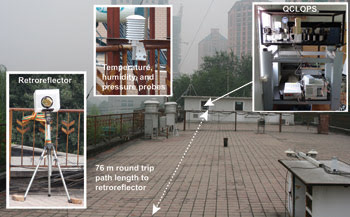
Field deployment of QCLOPS at the Institute for Atmospheric Physics, Chinese Academy of Sciences. Courtesy Anna Michel, Princeton University.
The laser system itself consisted of the QCLOPS, which directed a laser beam to a reflector that then bounced the beam back to the system. Other probes measured humidity, air pressure and temperature. The open-path sensor, placed on the roof of the two-story Institute of Atmospheric Physics about two miles from Olympic National Stadium (known as the “Bird’s Nest”), made a round-trip pass of 76 m, a distance determined by the roof’s size.
“Ideally, we’d like to do a kilometer, and with newer, higher power lasers, we should be able to go further,” Michel said.
QCLOPs could operate for a month at a time without human intervention; any disruptions in the beam caused by people walking through or by flying birds simply appeared as blank spots in the data.
Taking the system out of the lab yielded some surprises for the researchers.
“I was surprised by how well the sensors work on their own,” Gmachl said. “But you do learn to build them robust. You can build a great system, but in the end, if it needs a person to run it, you’re not saving anything.”
Guide beam needed
Because the IR wavelength is invisible to the naked eye, the team used a visible red guide beam to help align the invisible beam properly with the reflector.
“We definitely learned some engineering things,” Michel said. “The setup didn’t work as well as it should.”
Still, “the students do develop an amazing intuition as to where the beam is,” Gmachl said.
Another issue discovered with the sensor in the field is keeping it calibrated; occurrences such as power outages, which can happen on a regular basis in remote areas, can make it tricky to recalibrate the system, she said.
The data gathered by the sensors was just one part of the project; at the same time, environmental modeling of weather and air quality was being done at the Institute of Atmospheric Physics, the Chinese Academy of Sciences.
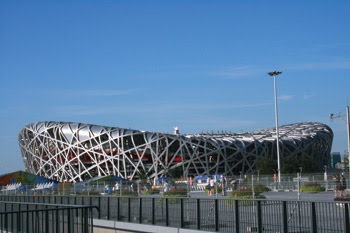
The Bird’s Nest is shown on a blue sky day. Courtesy Peter Q. Liu, Princeton University.
Beijing has an official population of just over 14 million. Sixty-two percent of the municipal land area is mountainous, making the city itself bowl-shaped, so pollution blows in and becomes trapped until there is sufficient wind to blow it away. The researchers are now analyzing the data they gathered to determine what percentage of the air clearing was caused by human efforts and what percentage by the wind, Michel said.
I can see clearly now
It is apparent, however, even without the official data, that the efforts China made to limit smog during the games, coupled with a change in the weather pattern, made a noticeable impact on air quality, as the skies cleared significantly during the games. Officials moved high-polluting plants such as iron and steel producer Shougang Group out of the city, revamped gas stations to curb petroleum vaporization, idled construction sites, improved public transportation and limited use of cars only to odd or even days.
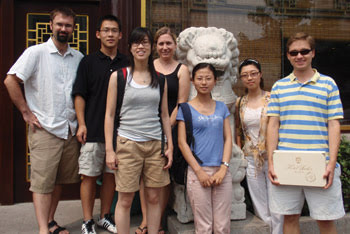
Team MIRTHE members participated in an international air quality monitoring project in Beijing. From left to right: Rafal Lewicki, Peter Liu, June Yeung, Anna Michel, Xue Huang, Yan Zhang, Raleigh Martin.
The MIRTHE team, which included several graduate students who are Chinese nationals, was conscious of the fact that Chinese officials were trying to keep bad press to a minimum while the world was watching Beijing.
Still, “everything went off really well during the Olympics and made a lot of people worried about the air quality feel better,” Michel said.
A great engineering project
“This was a great engineering project. It showed that if you put your mind to it, you can really change air quality,” Gmachl said. “Part of the experiments we do help form this decision making. Ultimately, we hope to use data of this kind and others to say: ‘It does matter.’ Moving people from driving their own cars to using public transportation does make a difference.”
After the team left Beijing, the QCLOPS remained there for about another month, being monitored by graduate students at the institute. The students then shipped it and its data back to Princeton. Michel and other members of the research team are still processing that data and hope to have their first paper published in the coming months in the journal Environmental Science and Technology.
Since the Olympics, China appears to have kept some of its environmental protection measures in place; the economic downturn also has affected air quality for the better. April was touted as Beijing’s best month for air quality since 2000, with the city experiencing 23 “blue sky” days, when the air pollution index (API), which monitors five airborne pollutants, fell below 100, meaning that there were no health implications.
Officials said April was also the first month in nine years that no day had an API higher than 150, when people with breathing or heart problems can experience difficulties. The concentration of particulates in the air also dropped 25 percent from the previous year.
“Thanks to consistent environmental protection measures such as traffic control, green construction and a ban on heavy-polluting vehicles, we have achieved great improvement in the capital’s air quality,” Du Shaozhong, deputy director of the Beijing municipal environmental protection bureau, told the China Daily newspaper in early May.
Under the new administration, the US also appears poised to change its attitude and actions toward the environment.
Under the proposed (at press time) American Clean Energy and Security Act of 2009, Congress would allow companies to cap their emissions and trade their excess pollution credits to others in an effort to cut overall carbon emissions. The so-called cap-and-trade bill, as well as other government efforts to reduce greenhouse gas emissions, also is helping to raise the public profile of air quality.
It could lead to an increased demand for systems such as the ones developed at MIRTHE, which are sensitive enough to measure concentrations of one part in 1 billion atoms.
From a company’s perspective, “maybe you want to measure what you’re producing, if you have to pay for that amount,” Gmachl said.
“It’s certainly an exciting time to be an engineer, a climate scientist and in other fields – important for society,” she said.
That helps reinforce one of the points Gmachl likes to make in the classroom.
“Engineers are part of what matters. That’s something we want to teach our students – their training is important and actually matters,” she said.
One of MIRTHE’s goals is to develop a handheld sensor that has the sensitivity of a mass spectrometer, something that engineers at Rice are working on.
“The smallest ones do fit in the palm of the hand, but they’re engineering models rather than consumer products right now,” Gmachl said.
As for the QCLOPS sensor, it’s in Ghana for the next few months, analyzing the gases present in the masses of plant matter burned to smoke vast quantities of fish. The sensor was sent there under an international student exchange program that emphasizes the fact that global climate change is a global problem.
“Urban pollution is not just an urban issue,” Gmachl said. “Being able to collaborate across borders with international research groups is important.”